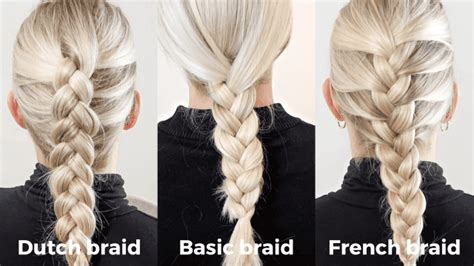Introduction
When it comes to adding a touch of elegance and sophistication to your hair, braids are a timeless choice. Among the most popular braiding techniques are Dutch braids and French braids, each offering a distinct look and feel. This comprehensive guide will delve into the differences between these two braiding methods, highlighting their unique characteristics, techniques, and styling possibilities.

Key Differences Dutch Braids vs. French Braids
- Placement of Strands:
-
Dutch braids (also known as inside out braids) are created by crossing the outer strands under the middle strand, while French braids cross the outer strands over the middle strand.
-
Tightness:
-
Dutch braids are typically tighter and closer to the scalp, creating a raised and prominent effect. French braids tend to be looser and less defined.
-
Overall Effect:
- Dutch braids result in a more voluminous and textured look, while French braids create a smoother and more polished appearance.
Dutch Braids
-
Divide and Section:
– Start by sectioning your hair into three equal strands at the crown of your head. -
First Interlace:
– Cross the right strand under the middle strand, then cross the left strand under the new middle strand. -
Weaving New Strands:
– As you continue braiding, grab a small section of hair from the right side, cross it under the right strand, then do the same on the left side. -
Tighten and Repeat:
– Pull the strands tightly while crossing them to create a secure and raised braid. Repeat steps 2-3 until you reach the end of your hair.
French Braids
-
Divide and Section:
– Similarly to Dutch braids, divide your hair into three equal strands at the crown. -
First Interlace:
– Cross the right strand over the middle strand, then cross the left strand over the new middle strand. -
Weaving New Strands:
– Take a small section of hair from the right side, cross it over the right strand, then repeat on the left side. -
Loosely Interlace:
– Instead of pulling the strands tightly, allow them to remain slightly loose to create a more relaxed and fluid braid.
Dutch Braids
- Messy Bun:
-
Braid your hair into a Dutch braid, then loosen it up by gently pulling at the sides to create a messy yet chic bun.
-
Half-Up, Half-Down:
-
Braid a Dutch braid from the front of your head to the crown, leaving the rest of your hair down for a romantic and playful look.
-
Cornrows:
- Create multiple tight Dutch braids close to the scalp, often used in African hairstyles to protect hair and promote hair growth.
French Braids
- Classic Chignon:
-
Braid your hair into a French braid, then wrap it into a sleek and elegant chignon at the nape of your neck.
-
Fishtail Braid:
-
French braid your hair, then divide it into two sections and cross small strands from each side to create a fishtail effect.
-
Crown Braid:
- Start a French braid from one side of your head, wrap it around your head like a crown, and secure it on the other side.
The choice between Dutch braids and French braids ultimately depends on your personal style and the occasion.
-
For a bold and voluminous look: Dutch braids
-
For a more elegant and polished appearance: French braids
-
For casual or bohemian vibes: Messy Dutch braids
-
For special occasions or formal events: Classic French braids
Additional Tips
- Practice Makes Perfect:
-
The more you practice, the better you’ll become at braiding. Don’t get discouraged if your first attempts aren’t perfect.
-
Use a Mirror:
-
If you’re having trouble seeing the back of your head, use a mirror to assist you.
-
Secure with Elastic:
-
Once you’ve finished braiding, use a clear elastic to hold the ends in place.
-
Add Accessories:
-
Embellish your braids with hair clips, ribbons, or flowers for an extra touch of style.
-
Consider Hair Extensions:
-
If you have fine or short hair, hair extensions can add volume and length for more impactful braids.
-
Get Creative:
- Don’t be afraid to experiment with different variations and combinations of braids. The possibilities are endless.
